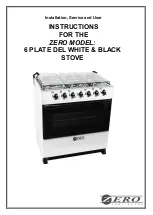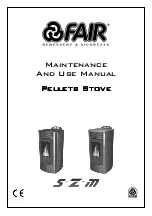
November 5, 2015
23
Maintenance
Ash Removal
The wood burning makes some residual called ash and it must
be removed from the combustion chamber to help oxygen
circulation.
The ash has to be removed periodically every 2 or 3 days
during heavy warming period. Never have an excessive
accumulation in the combustion chamber, because it can
reduce performances of your stove by diminishing the air
circulation between logs.
The best time to remove ash is after a long warming period like
morning when the stove is relatively cold enough to manipulate
the ash and the chimney is still hot. The hot chimney draft will
vacuum the dust inside the stove.
To remove the ash from combustion chamber, you must have
following tools.
•
Ash shovel;
•
Ash brush;
•
A metal bucket with airtight lid.
Some embers are mixed with ash and still lit a few hours or a
few days. It’s very important that the metal lid is airtight. The
bucket must be put on non-combustible tiles or bricks.
Ash Disposal
Some embers are mixed with ash and still lit. If there is enough
oxygen, they can still light some hours or even a few days.
It’s mandatory to store ash pending disposal:
•
Into a metal container with an airtight metal lid
correctly closed;
•
Outside the house directly on gravel, on a concrete
slab, on bricks or any other non-combustible
materials;
•
Far enough from combustible material;
•
No inflammable liquid must be in proximity.
If the ash are disposed of by burial in soil or otherwise locally
dispersed, they should be retained in the closed container until
all cinders have thoroughly cooled.
NEVER PUT WASTE IN THE ASH CONTAINER.
Creosote Formation
When wood is burning slowly, it produces tar and other organic
vapors, which are combined with expelled moisture to form
creosote. The creosote vapor condense in the relatively cool
chimney flue of a slow-burning fire. As a result, creosote
residue accumulates on the flue lining. Creosote can take
several forms such as tarry liquid, black soot or crystals. When
it catches fire, this creosote produces an extreme heat and it
might cause a chimney fire.
The chimney connector and chimney should be inspect at least
once a week during the first month to determine if a creosote
buildup has occurred and to see how often you have to sweep
it. Warmer is your fire, less creosote buildup occurs.
Contact your local fire authority to know how to handle a
chimney fire.
Chimney Inspection
Wood moisture, wood species, the combustion quality and
other conditions are the factors that can influence creosote
buildup speed in the chimney and the chimney connector.
The chimney and the chimney connector must be inspected at
least one every two month during the warming season or more
depending on your installation. You can call a Chimney
sweeper to evaluate the creosote formation or you can do it
yourself - extinguish the wood stove and wait until it cools
down. Unscrew the flue collar and stove collar to inspect them,
then verify the inside of the chimney with a spot light to see if a
creosote buildup has occurred.
For a masonry chimney, insert a mirror in the cleanout opening
at the bottom. For an outdoor factory build chimney, open the
cap at the bottom of chimney for cleaning. It is preferable to do
the inspection during the daytime on a sunny day.
If you see 1/8 inch (3 mm) or more creosote buildup, the
chimney diameter appears smaller or if you cannot see the
chimney cap, it is time to sweep the chimney and the chimney
connector to remove creosote.
Chimney Sweeping
Chimney Sweeping needs special tools such as fiberglass
rods, an adapted diameter brush and some ropes.
Sweeping chimney also requires to climb on the roof and
higher chimney section as well to remove the chimney cap, if
applicable.
We recommend to call a Professional chimney Sweeper
certified by APC in Quebec, the WETT in the rest of Canada or
by NFI in United States.







































